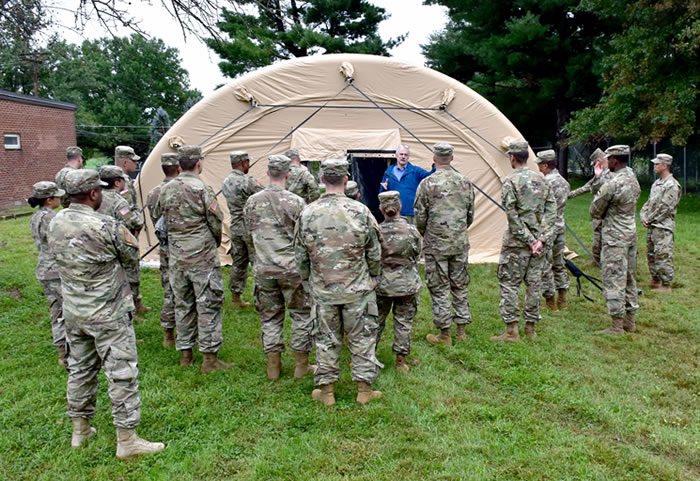USAMMDA Team Spotlight: Medical Support Systems and Evacuation Project Management Office

The Medical Support Systems and Evacuation Project Management Office of the U.S. Army Medical Materiel Development Activity at Fort Detrick, Maryland, is comprised of a multidisciplinary team with broad mission capabilities for the development of medical products used to sustain and support the Warfighter. The team's product and logistics managers and model-makers are highly experienced in project management, lifecycle management, engineering, fabrication and technical testing.
In our continuing spotlight series, we now focus on the MSSE PMO, as USAMMDA's public affairs team met recently with MSSE PMO project manager Steven Hawbecker. In relating the important work of his team, Hawbecker provided a great deal of insight regarding the products that are helping to further USAMMDA's mission to develop and deliver critical medical capabilities to protect, treat and sustain the health of Service Members worldwide.
PAO: Within Army Medicine, what is the role of USAMMDA's Medical Support Systems and Evacuation Project Management Office?
SH: The Army is a very complex system, and within the Army there are multiple integrations that must be done. There are various Program Executive Offices that focus on weapons systems, the Soldier, on ground combat systems – and the integration of medical capabilities into those Program Management Offices is very important. And this is what the MSSE PMO does, and does very well. We reach out and leverage technologies to integrate into the Soldier, into the wheeled and tracked vehicles, into the Field Support Hospital – and then we make these successful together.
The MSSE PMO has a number of unique capabilities. We are the arm of the medical branch that reaches out to the other PEOs within the Army. We support their systems, such as the Armored Multi-Purpose Vehicle, or the Soldier on the ground. With that, we integrate medical technologies into those big weapons systems programs, so that we all can be successful in that environment.
PAO: What is the overall mission and goal of the MSSE PMO?
SH: The mission of the MSSE PMO is to develop and deliver quality medical solutions to protect and treat our deployed Warfighters. In light of this, we maintain the goal that these must be deployable, they must be maintainable and sustainable, and must perform when needed. To accomplish this, we utilize a multidisciplinary team of engineers and logisticians, and we have a prototype development laboratory where we can rapidly prototype products.
After we prototype these products, we then utilize a cost, schedule and performance format, and this is the key to our success. We focus primarily on cost and schedule, and do our best to ensure high performance of the product, and we work to get these products to the field as quickly as possible for our Warfighters.
PAO: Can you please detail some of the current products managed by the MSSE PMO?
SH: The MSSE PMO focuses on five different commodity areas: Preventative Medicine, Operational Medicine, Medical Evacuation and Treatment Platforms, Medical Shelters Infrastructure, and Combat Casualty Care Support Systems. We develop, rapidly prototype, test, and procure products for preventative medicine, combat casualty care support and operational medicine. Let's start with physical preventative medicine. In this area, we focus on insecticide repellants for the uniforms. We're working on this to repel vectors. From that, we focus on the insecticide-impregnated bed net, which we've developed to keep Soldiers safe from flying vectors while they're sleeping, or where they are billeting.
We also work within operational medicine, and the focus area of these products has been Soldier Optimization Support. Applications here involve mission planning – for example, we determine if they will become altitude sick, and how much water they will need in the field, for those that have been fielded.
With regard to Combat Casualty Support, we work with the PEOs for ground combat systems and combat support systems. For the Mine-Resistant Ambush Protected vehicles and Casualty Evacuation Systems, we do the back end of the ambulances. For the new Armored Multi-Purpose Vehicle, we make sure we optimize the rear of that particular treatment vehicle, and the ambulance variance for casualties. We support the Combat Support Hospital, which recently has become the Field Hospital. We fielded new Temper Air-Supported Shelters, and have worked on advanced water systems for the military. We have also worked on an enhanced rigid-wall shelter for X-ray and other commodities inside that shelter system.
PAO: How do you feel about your work, and the work of the MSSE PMO team?
SH: First of all, it is very rewarding here. I came from a background where I did weapons testing, which was very fascinating. But here I touch the Soldier, and I help to save lives. I don't directly save the life, but I help provide the critical tools to do this – for our combat medics, for our entomology specialists, for preventative medicine. And when I receive feedback from our junior enlisted, or from our junior officers, on how these important products have been deployed and helped them during their deployment, that's truly the most rewarding part of my job!
To watch a video of the interview with Steven Hawbecker, click the following link: MSSE PMO Interview.













